How to Quickly Make a Table for WordPad
Method 1 of 3:
Creating an HTML Table
-
 Start a new WordPad document. You can use WordPad to create a table in HTML that can be open and displayed in any web browser.
Start a new WordPad document. You can use WordPad to create a table in HTML that can be open and displayed in any web browser. -
 Add the table tags. These are the tags that your table code will be enclosed in.
Add the table tags. These are the tags that your table code will be enclosed in.<table> table>
-
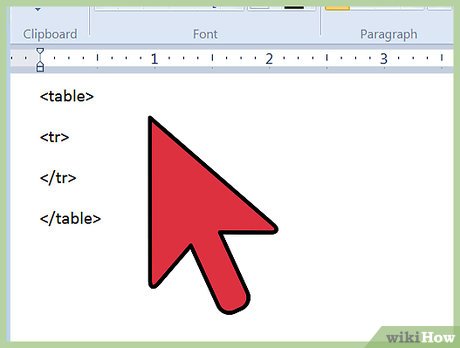 Add the first row to your table. This will be the header row for your table.
Add the first row to your table. This will be the header row for your table.<table> <tr> tr> table>
-
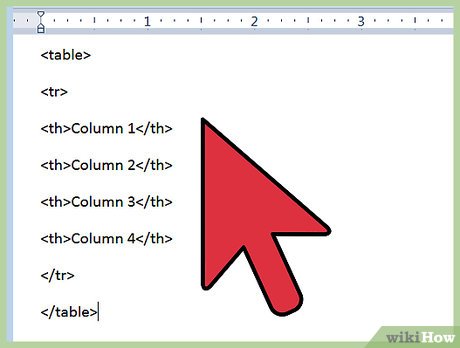 Add the table headings to the first row. Use the table heading tags to add as many columns as you would like.
Add the table headings to the first row. Use the table heading tags to add as many columns as you would like.<table> <tr> <th>Column 1th> <th>Column 2th> <th>Column 3th> <th>Column 4th> tr> table>
-
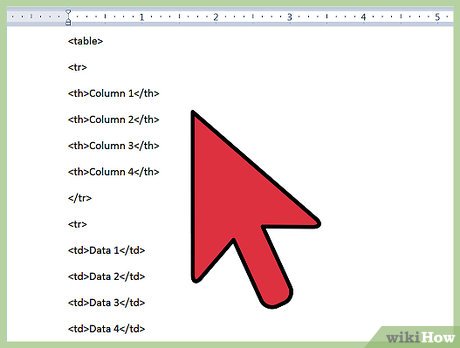 Add another row beneath the headers. Now that you have your column headings, you can add your first row of data.
Add another row beneath the headers. Now that you have your column headings, you can add your first row of data.<table> <tr> <th>Column 1th> <th>Column 2th> <th>Column 3th> <th>Column 4th> tr> <tr> <td>Data 1td> <td>Data 2td> <td>Data 3td> <td>Data 4td> tr> table>
-
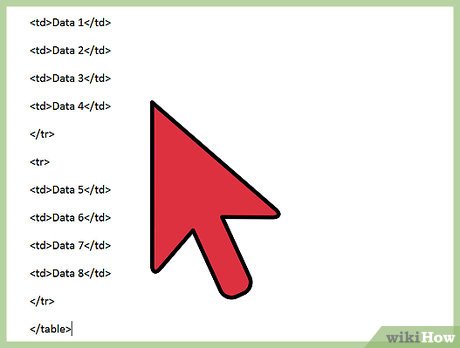 Continue adding rows. You can use the tags to continue adding rows of data to your table. Make sure that you close each one with a tag.
Continue adding rows. You can use the tags to continue adding rows of data to your table. Make sure that you close each one with a tag.<table> <tr> <th>Column 1th> <th>Column 2th> <th>Column 3th> <th>Column 4th> tr> <tr> <td>Data 1td> <td>Data 2td> <td>Data 3td> <td>Data 4td> tr> <tr> <td>Data 5td> <td>Data 6td> <td>Data 7td> <td>Data 8td> tr> table>
-
 Click File and select "Save as." This will allow you to save the document as an HTML file. It needs to be in HTML format so that you can see the table when you load it in a web browser.
Click File and select "Save as." This will allow you to save the document as an HTML file. It needs to be in HTML format so that you can see the table when you load it in a web browser. -
 Select "Text" from the "Save as type" menu. This lets you change the extension.
Select "Text" from the "Save as type" menu. This lets you change the extension. -
 Change the extension at the end of the file name to .html. This will change the format to HTML format.
Change the extension at the end of the file name to .html. This will change the format to HTML format. -
 Save the file. You can now name and save the file as whatever you'd like. Make sure that it has the .html extension.
Save the file. You can now name and save the file as whatever you'd like. Make sure that it has the .html extension. -
 Open the file in a web browser. Double-click the newly-created HTML file to load it in your default web browser. Your table will appear in the browser window.
Open the file in a web browser. Double-click the newly-created HTML file to load it in your default web browser. Your table will appear in the browser window.
Method 2 of 3:
Using a Spreadsheet Program
-
 Ensure Excel or OpenOffice is installed. If you need a little more control over the table, you can use a spreadsheet program. You'll essentially be inserting a spreadsheet into your WordPad document. This requires a compatible spreadsheet editor. WordPad supports Excel and and OpenDocument formats.
Ensure Excel or OpenOffice is installed. If you need a little more control over the table, you can use a spreadsheet program. You'll essentially be inserting a spreadsheet into your WordPad document. This requires a compatible spreadsheet editor. WordPad supports Excel and and OpenDocument formats.- OpenOffice and LibreOffice are both free office suites that support the OpenDocument format. See How to Install Open Office for detailed instructions on installing OpenOffice for free.
-
 Click the "Insert object" button in WordPad. In newer versions, this can be found in the Insert section of the Home tab. In older versions of WordPad, click the "Insert" menu and select "Object".
Click the "Insert object" button in WordPad. In newer versions, this can be found in the Insert section of the Home tab. In older versions of WordPad, click the "Insert" menu and select "Object". -
 Select the Worksheet option. A list of objects that you can insert will appear. If you have Excel installed, you can select "Excel Worksheet". If you have OpenOffice or LibreOffice installed, you can select "OpenDocument Spreadsheet". Selecting one of these objects will insert a blank spreadsheet in your WordPad document, and your spreadsheet program will open in another window.
Select the Worksheet option. A list of objects that you can insert will appear. If you have Excel installed, you can select "Excel Worksheet". If you have OpenOffice or LibreOffice installed, you can select "OpenDocument Spreadsheet". Selecting one of these objects will insert a blank spreadsheet in your WordPad document, and your spreadsheet program will open in another window. -
 Fill out the table data in the spreadsheet program. After inserting the table, Excel or your OpenDocument spreadsheet editor will open. Anything you enter into the cells in your spreadsheet editor will appear in the table that you inserted into the WordPad document. Go through each cell and fill out the table with the important information.
Fill out the table data in the spreadsheet program. After inserting the table, Excel or your OpenDocument spreadsheet editor will open. Anything you enter into the cells in your spreadsheet editor will appear in the table that you inserted into the WordPad document. Go through each cell and fill out the table with the important information.- Even though only a small range of cells is shown in WordPad, the range will expand as you add data outside of the displayed range. If the table is smaller than the initial range, the table will shrink to fit your data.
-
 Format the text. You can use the text formatting tools in your spreadsheet program to change the look for the text in the cells. You can change the font, size, color, and emphasis. Formatting text in Excel or your other spreadsheet program is very similar to formatting text in a word processor. The changes you make to the formatting will be displayed immediately in the WordPad table.
Format the text. You can use the text formatting tools in your spreadsheet program to change the look for the text in the cells. You can change the font, size, color, and emphasis. Formatting text in Excel or your other spreadsheet program is very similar to formatting text in a word processor. The changes you make to the formatting will be displayed immediately in the WordPad table.- You can create headers by bolding the contents of the first row in the spreadsheet program.
-
 Resize your cells. Changes in the size of the rows and columns in your spreadsheet editor will be reflected in the table in your WordPad document immediately. Change the cell size to make your information easy to read.
Resize your cells. Changes in the size of the rows and columns in your spreadsheet editor will be reflected in the table in your WordPad document immediately. Change the cell size to make your information easy to read. -
 Close the spreadsheet editor. This will finalize the data and you'll see your finished table in WordPad.
Close the spreadsheet editor. This will finalize the data and you'll see your finished table in WordPad. -
 Move and resize the table. You can drag the boxes around the edge of the table to resize it. The content of the table will grow or shrink to match the new size. You can click and drag the table around your document as well.
Move and resize the table. You can drag the boxes around the edge of the table to resize it. The content of the table will grow or shrink to match the new size. You can click and drag the table around your document as well. -
 Double-click the table to make edits. This will open your spreadsheet editor, allowing you to change the table data. If you've resized the table, it will be reverted to the original size when you edit it. You'll have to resize it again after editing.
Double-click the table to make edits. This will open your spreadsheet editor, allowing you to change the table data. If you've resized the table, it will be reverted to the original size when you edit it. You'll have to resize it again after editing.
Method 3 of 3:
Using the Keyboard (Windows 8 or Newer)
-
 Know which versions of WordPad this works in. Creating a table using your keyboard is only supported in Windows 8 or newer versions of WordPad. If you are running Windows 7 or earlier, you'll need to try one of the other methods in this article.
Know which versions of WordPad this works in. Creating a table using your keyboard is only supported in Windows 8 or newer versions of WordPad. If you are running Windows 7 or earlier, you'll need to try one of the other methods in this article. -
 Place your cursor where you want your table to start. When you're using your keyboard to insert automatic tables, the table will start on the line you are currently working on. You can start a table anywhere in your document.
Place your cursor where you want your table to start. When you're using your keyboard to insert automatic tables, the table will start on the line you are currently working on. You can start a table anywhere in your document. -
 Create the first row. Use + and - to create the measurements for the first row of cells. Start and end each cell with a +, and use - to indicated how many characters wide the cell is. Don't worry too much about the actual measurements, as you can make adjustments later. See below for an example first row:
Create the first row. Use + and - to create the measurements for the first row of cells. Start and end each cell with a +, and use - to indicated how many characters wide the cell is. Don't worry too much about the actual measurements, as you can make adjustments later. See below for an example first row:- +----------+-----+---------------+
-
 Press .↵ Enter to generate the first row. Your characters will turn into the first row of the table, with the + signs becoming the borders of the cells. You can start typing text into each of the cells. The cells will resize automatically if the amount of text is too much to fit.
Press .↵ Enter to generate the first row. Your characters will turn into the first row of the table, with the + signs becoming the borders of the cells. You can start typing text into each of the cells. The cells will resize automatically if the amount of text is too much to fit. -
 Add additional rows. Move the cursor to the very end of the first row, so that it is flashing right on the outside of the table border. Press ↵ Enter to create a second row for the table. Repeat this process to continue adding rows to the table.
Add additional rows. Move the cursor to the very end of the first row, so that it is flashing right on the outside of the table border. Press ↵ Enter to create a second row for the table. Repeat this process to continue adding rows to the table.- Pressing Tab ↹ while in the last cell will create a new row. Continuing to press Tab ↹ will move to the next available cell, creating a new row when you reach the end of the last row of the table.
-
 Resize your rows and columns. Once you've added a few rows, you can use your mouse to resize them. Find the border that you want to move and click and drag it.
Resize your rows and columns. Once you've added a few rows, you can use your mouse to resize them. Find the border that you want to move and click and drag it. -
 Add your content. Now that the table has been created, you can start adding your information to it. Simply move from cell to cell and enter the information that you want to add to the table. You can highlight and format the text however you'd like.[1]
Add your content. Now that the table has been created, you can start adding your information to it. Simply move from cell to cell and enter the information that you want to add to the table. You can highlight and format the text however you'd like.[1] -
 Save the file as a Rich Text Format (.rtf) file. This format will keep your newly-created table. If you save it as a text (.txt) file, your table formatting will be lost. Rich Text Format files can be opened in most word processors.
Save the file as a Rich Text Format (.rtf) file. This format will keep your newly-created table. If you save it as a text (.txt) file, your table formatting will be lost. Rich Text Format files can be opened in most word processors.- You can also save it as a OpenOffice XML Document (.docx), which can be opened in Word.
3.9 ★ | 11 Vote
You should read it
- How to create Google Spredsheet automatically updates data
- Microsoft introduced a new tool to turn an image table into an editable Excel table
- 35 tools, scripts and plugins to build HTML Table
- How to align spreadsheets before printing on Google Sheets
- How to filter data in Excel
- How to Create a Form in a Spreadsheet
- How to Make a Shared Spreadsheet
- How to Make a Spreadsheet
May be interested
- How to do automatic table of contents in Word 2013, 2016
 how to make automatic table of contents in word 2013, 2016. unlike manual table of contents creation, automatic table of contents helps you edit and update text content quickly, easily without losing the typing. back the table of contents whenever there is a change in content. at b
how to make automatic table of contents in word 2013, 2016. unlike manual table of contents creation, automatic table of contents helps you edit and update text content quickly, easily without losing the typing. back the table of contents whenever there is a change in content. at b - Instructions for deleting table paths in Word
 in the process of creating tables on word, sometimes you need to delete some table lines to meet needs or make the table easier to see. so how can i delete the table line and keep the content in word?
in the process of creating tables on word, sometimes you need to delete some table lines to meet needs or make the table easier to see. so how can i delete the table line and keep the content in word? - Table operations in Word
 introduce table operations in word. table operations in word 2013 include: 1. draw cells in a table. - creating a table can not ignore merge cell operation, for example, if you want the column of the school day to have 2 values of even and odd dates, make 2 columns into one.
introduce table operations in word. table operations in word 2013 include: 1. draw cells in a table. - creating a table can not ignore merge cell operation, for example, if you want the column of the school day to have 2 values of even and odd dates, make 2 columns into one. - How to Make Your Word Document Stand Out with a Beautiful Table of Contents
 a well-designed table of contents can set your entire document apart. microsoft word makes it easy to insert a table of contents. then, with just a few simple design tweaks, you can make your table of contents really stand out.
a well-designed table of contents can set your entire document apart. microsoft word makes it easy to insert a table of contents. then, with just a few simple design tweaks, you can make your table of contents really stand out. - Instructions on how to create automatic table of contents in Word quickly 2020
 you have a long word document file, you want to create an automatic table of contents to make it easy to find the content in the file. so, please refer to the article on how to create automatic table of contents in word below.
you have a long word document file, you want to create an automatic table of contents to make it easy to find the content in the file. so, please refer to the article on how to create automatic table of contents in word below. - TEMPORARY TABLE temporary table in SQL
 temporary table, also known as temporary table, is a special form of table that is temporarily stored and handles intermediate results on sql
temporary table, also known as temporary table, is a special form of table that is temporarily stored and handles intermediate results on sql - Instructions for inserting table captions in Word
 similar to other content in word, you can insert a caption for the table to explain the content of the table or simply enter a name for the table to make it easier for people to follow.
similar to other content in word, you can insert a caption for the table to explain the content of the table or simply enter a name for the table to make it easier for people to follow. - How to make a table of contents in Word 2016
 how to make a table of contents in word 2016. an automatic table of contents not only helps you summarize the main content but also helps you easily find the content you want to view. if you do not know how to make an automatic table of contents in word, please refer to the article
how to make a table of contents in word 2016. an automatic table of contents not only helps you summarize the main content but also helps you easily find the content you want to view. if you do not know how to make an automatic table of contents in word, please refer to the article - Quickly change the location of a row in the Word 2013 table
 have you ever created a long table in word and then realized you need to rearrange the rows? in that case, you can easily move the rows up or down using a shortcut key combination.
have you ever created a long table in word and then realized you need to rearrange the rows? in that case, you can easily move the rows up or down using a shortcut key combination. - How to draw a table in Excel
 how to draw a table in excel. excel spreadsheets are great tools for calculating numbers. in this article, you can help excel table guys as quickly as possible.
how to draw a table in excel. excel spreadsheets are great tools for calculating numbers. in this article, you can help excel table guys as quickly as possible.

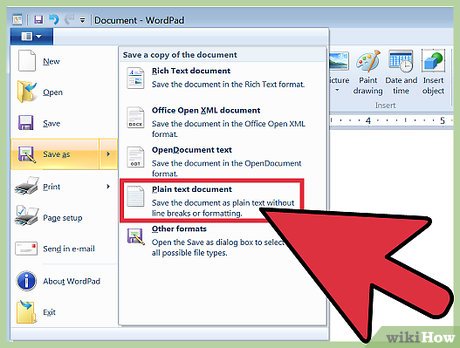


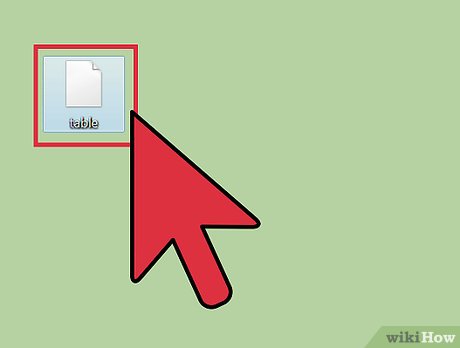
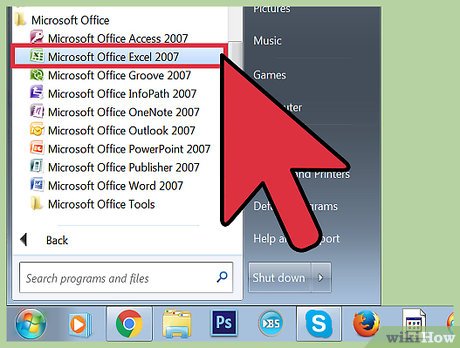


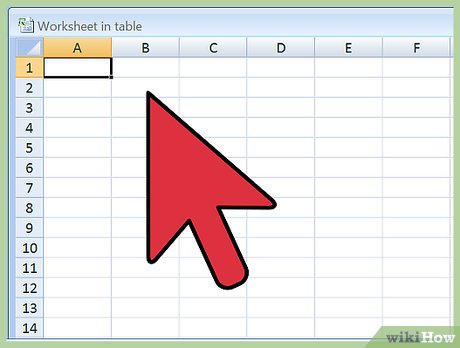
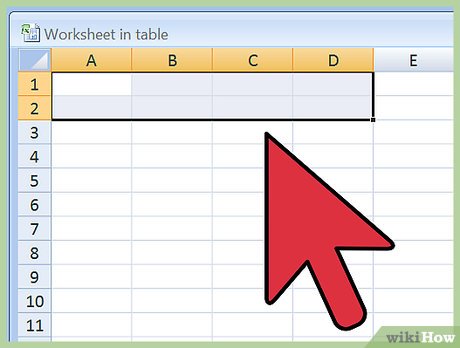
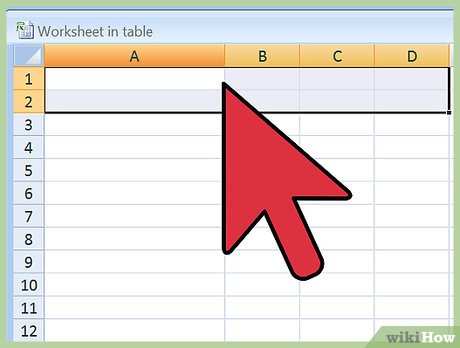
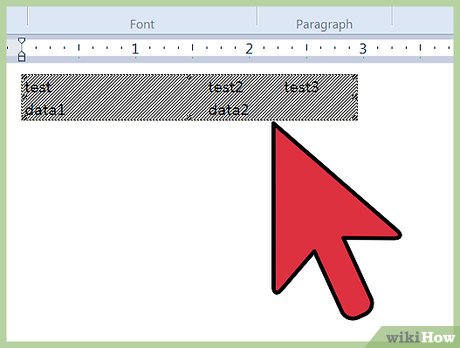
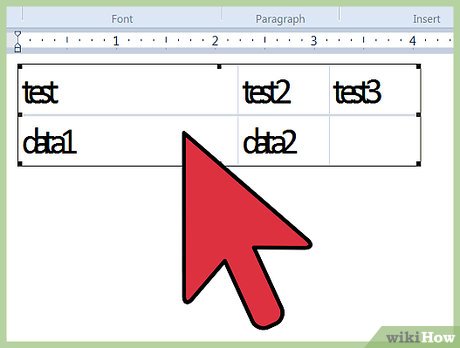
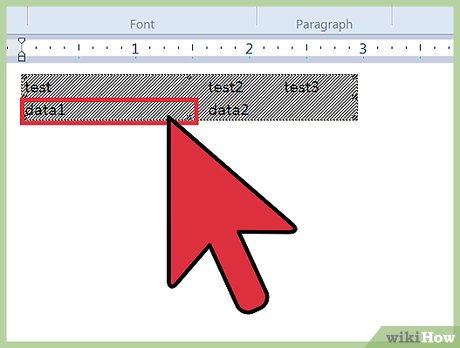
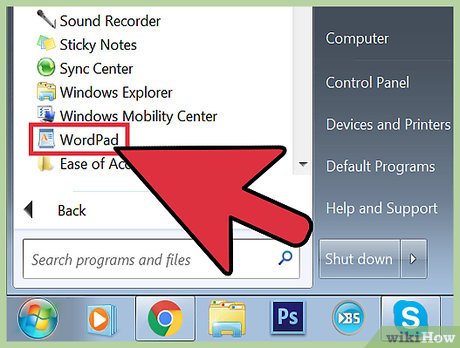
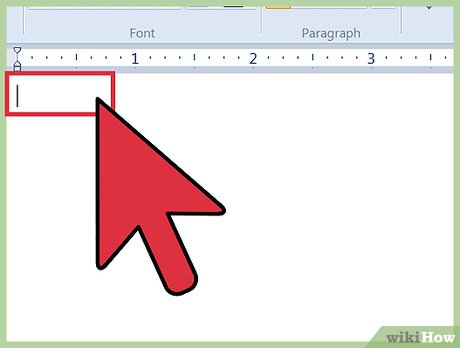
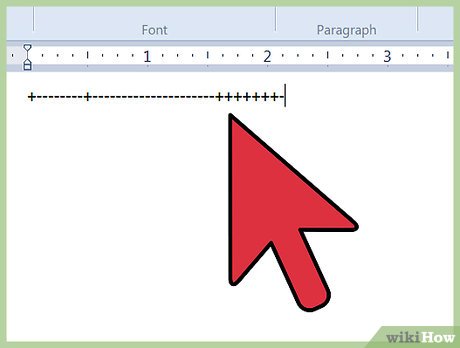
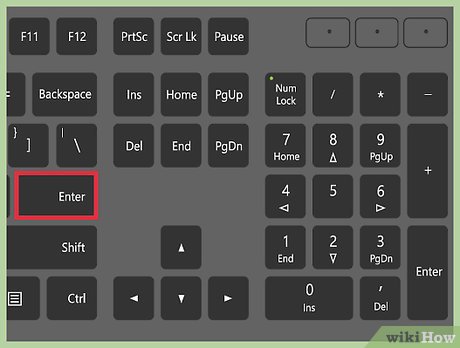
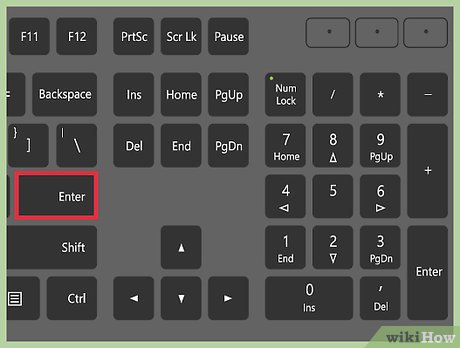
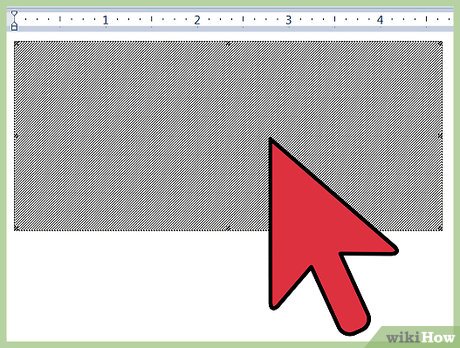
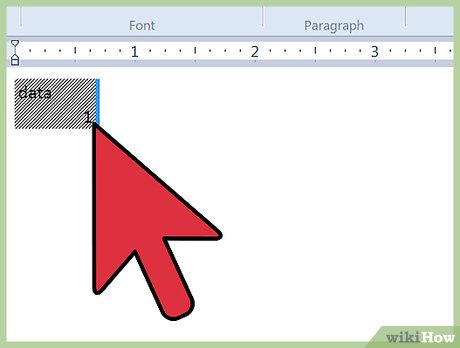
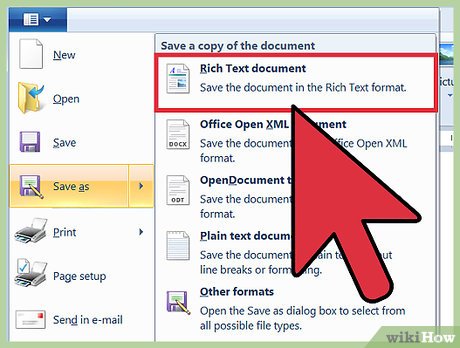










 How to Optimize Your PC Performance
How to Optimize Your PC Performance How to Fix the Blue Screen of Death on Windows
How to Fix the Blue Screen of Death on Windows How to Turn Off the Microsoft Narrator Start Up
How to Turn Off the Microsoft Narrator Start Up How to Turn Off BitLocker
How to Turn Off BitLocker How to Enter BIOS
How to Enter BIOS How to Format a Computer
How to Format a Computer